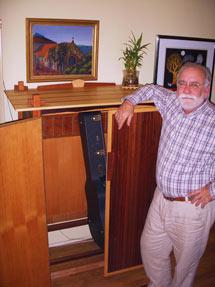
Handy Links
SLAC News Center
SLAC Today
- Subscribe
- Archives: Feb 2006-May 20, 2011
- Archives: May 23, 2011 and later
- Submit Feedback or Story Ideas
- About SLAC Today
SLAC News
Lab News
- Interactions
- Lightsources.org
- ILC NewsLine
- Int'l Science Grid This Week
- Fermilab Today
- Berkeley Lab News
- @brookhaven TODAY
- DOE Pulse
- CERN Courier
- DESY inForm
- US / LHC
SLAC Links
- Emergency
- Safety
- Policy Repository
- Site Entry Form

- Site Maps
- M & O Review
- Computing Status & Calendar
- SLAC Colloquium
- SLACspeak
- SLACspace
- SLAC Logo
- Café Menu
- Flea Market
- Web E-mail
- Marguerite Shuttle
- Discount Commuter Passes
-
Award Reporting Form
- SPIRES
- SciDoc
- Activity Groups
- Library
Stanford
Around the Bay
People: Frank Cooper and the Golden Rectangle
When Frank Cooper's wife wanted a cabinet that would hide the nest of cables behind the television, he built one. When she wanted a bigger one, he built that, too. Then Cooper decided to enter his creation into the 2009 California Home and Design competition. He won.
"I've been working with my hands all my life," said Cooper, who supervises a team of vacuum and mechanical technicians responsible for maintaining the experimental hutches at the Linac Coherent Light Source.
Cooper has worked at SLAC for about 15 years, "off and on," he said. He spent five years at the Stanford Synchrotron Radiation Lightsource designing, building, installing and maintaining beamline equipment, mostly for the small angle scattering group. He has also been part of the Mechanical Design group, where he designed equipment for fiducializing—that is, aligning the magnets and undulator relative to the LCLS electron beam. He was later a designer for the Surface Material Science group, where he worked on the electron cloud chamber for the International Linear Collider.
When he was one of many at SLAC let go due to budget constraints in early 2008, Cooper made the best of the situation. With some gentle nudging from his wife, he realized that he loved to design and build furniture, and that he had the free time to do it.
Cooper constructed his first pieces with recycled wood from his mahogany deck, which he had also built. He admitted that he "didn't know much about finishing at the time," so without the proper protection the wood succumbed to the weather. It eventually became warped, so he tore the deck down and used the planks for cabinets, coffee tables, mirrors and a coat rack.
Today, Cooper leaves most of the finishing to his wife, Lila, an accomplished artist and former professional ballerina. She sands each piece of furniture, and then carefully applies coats of a mixture of linseed oil, tung oil and polyurethane. The Coopers eventually ran out of the recycled deck wood, so they now purchase their mahogany, along with a variety of other exotic hardwoods, including ipe, ziracote, cocobolo and East Indian rosewood.
"Our pieces are a mix of Japanese, mission and craftsman styles," Cooper said. But he prefers not to call it furniture. "We make functional art."
By drawing on natural shapes and proportions, Cooper fuses a certain aesthetic into his work. Over time, he learned about the golden rectangle, whose side lengths are a ratio of 1 to 1.61. This relationship is considered by artists and mathematicians alike to be "beautiful," and it happens to appear frequently in nature. Cooper cuts wood for his tables and cabinets according to the ratio, but also uses it to determine the spacing between a piece's legs or shelves.
Recently, Cooper was rehired by SLAC to supervise a group of technicians matrixed to various projects at LCLS, where he works closely with the instrument scientists to install new experimental stations in the hutches. His group also repairs vacuum equipment and transports heavy instruments and other experimental equipment to and from the beamline. But he still finds time to work on his furniture with his wife a few nights a week and on weekends.
"The quality craftsmanship I demand from my group at SLAC is the same standard I apply to my furniture projects. I always think I can do a little better," he said.
óby Lauren Rugani
SLAC Today, December 15, 2010
